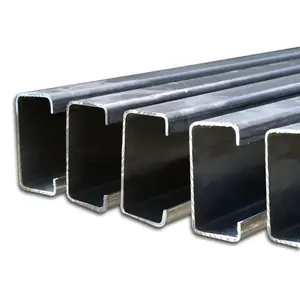
Stainless Steel U Channels And Brackets For Decks Metal Building Materials B-Channel Galvanized Steel Decking










In the competitive world of construction and industrial applications, the quest for quality materials at cost-effective prices is relentless. C channel steel, with its unique blend of strength, versatility, and durability, stands as a cornerstone in this search. This article delves into the intricacies of C channel steel, exploring its applications, features, and the diverse range available on Alibaba.com. We will navigate through the advantages of sourcing from this global marketplace and provide strategic insights on securing the best deals, ensuring that your business needs are met with both efficiency and economy.

Structural steel channels, commonly known as C-channel or U-channel steel due to their distinctive shapes, are notable for their parallel flanges and flat surfaces created through the hot rolling process. These elements are integral in various types of structures, offering essential strength, durability, and stability. The versatility of steel channels allows them to be effectively utilized in large-scale infrastructure like bridges, where they contribute to the integrity of trusses, trestles, and girders, as well as in smaller-scale applications such as wall studs, providing vertical support for various wall materials.
In the realm of construction, steel channels serve as a robust alternative to traditional materials, enhancing the structural soundness of rafters that support roof decks and other roofing materials. Their ability to distribute weight uniformly is crucial for maintaining ceiling integrity under pressure. Moreover, steel channels are employed in the automotive industry, where they are integral to the vehicle's framework, ensuring stability and safety for the machinery and occupants alike.
The adaptability of steel channels extends to their use in door frames, where they increase the lifespan of doors by protecting against wear and tear. Additionally, these channels can be treated to resist corrosion, which is particularly beneficial in environments that would otherwise degrade less durable materials. This treatment process, known as galvanizing, involves coating the steel with zinc to create a durable barrier against various environmental conditions.
Alibaba.com showcases a diverse range of C channel steel options to cater to various structural and construction needs. The selection includes galvanized strut channels, often used for seismic bracing and as seismic brackets, highlighting their durability and strength in supporting structures during seismic activity. Additionally, there are steel processing parts like galvanized U beam steel and structural steel C channels, available in different profiles, including the standard 41x41 size, which are essential components in modern construction.
The platform also offers specialized C channel steels such as S275JR and S355JR grades, which are known for their structural integrity and are commonly utilized in construction projects. For those seeking lightweight options, aluminum C channels are listed, which provide a balance between strength and ease of handling. These aluminum profiles are suitable for a variety of applications, including machinery use and bathroom fixtures, due to their corrosion resistance and aesthetic appeal.
For industrial and commercial applications, there are hot-dip galvanized and cold-formed steel C channels, which offer enhanced durability and support. These are ideal for creating robust frameworks and are available in various sizes and thicknesses to meet specific project requirements. The availability of customized sizes and finishes, such as zinc-coated carbon steel C channels, allows buyers to select products that match their specific needs, ensuring both functionality and visual consistency in their projects.
C channel steel is a versatile material used in various industries due to its unique C-shaped cross-section, providing strength and stability. In the construction sector, it's integral in creating robust frameworks for bridges, offering support to critical components like trusses and girders. Its durability makes it a preferred choice for wall studs, providing vertical support for walls and serving as a modern design element for room partitions.
Moreover, C channel steel plays a vital role in roofing as rafters, contributing to a more uniform weight distribution and enhancing resistance to heavy wind loads. In the automotive industry, it's essential for the vehicle framework, reinforcing the structure to protect components and minimize impact during collisions. Steel channels are also used in creating sturdy, low-maintenance enclosures for livestock and equipment in agriculture, as well as secure perimeters for commercial establishments.

American Standard Steel C Channels are characterized by their unique shape, which provides a versatile solution for a variety of structural applications. The dimensions of these channels are typically specified by the depth and weight per foot, such as a C 5 x 9, indicating a channel that is 5 inches deep and weighs 9 pounds per foot. Their I-shaped cross-section offers both aesthetic appeal and functional advantages, making them a popular choice in construction and engineering projects.
The properties of these channels are defined in imperial units, which are standard in the United States and often used in international projects. The static parameters of American Standard Steel C Channels are carefully engineered to ensure stability and strength in supporting loads. These channels are integral components in the creation of frameworks and can be easily integrated into various design models, including those created with advanced tools like the Engineering ToolBox Sketchup Extension.
The versatility of American Standard Steel C Channels is further enhanced by the range of related structural shapes and tools available for comprehensive design and planning. From beams and columns to different types of load support calculators, these channels work in conjunction with a wide array of structural elements to meet the demands of complex engineering challenges.
C channel steel, often known as 'American Standard Channels,' is a type of carbon structural steel that is well-suited for a variety of processing techniques. The A36 hot rolled steel channels are characterized by a rough, blue-grey finish and are made from a low carbon steel, which is noted for its durability and longevity. These channels are recognized by their 'structural shape,' which means one of their dimensions, not counting length, is greater than 3 inches. The inside flange surfaces of C channels have a distinctive slope of approximately 16-2/3%, setting them apart from 'MC' channels. The standard specification for this material is ASTM A36 / A36M-08, which establishes the criteria for carbon structural steel. This specification is a reference point for buyers seeking to understand the quality and standards of C channel steel available on platforms like Alibaba.com.

Sourcing C channel steel presents several advantages for businesses. The platform offers a diverse range of C channel steel types, including options in aluminum, carbon steel, and stainless steel, catering to various industry needs. The availability of customizable sizes and colors allows businesses to tailor their orders to specific requirements, ensuring that the product fits their project specifications precisely.
The C channel steel is designed to withstand high temperatures, which enhances its strength and durability. This makes it a reliable choice for long-term applications. Additionally, the material's resistance to cold increases its strength and reduces the likelihood of rust, which is crucial for maintaining structural integrity over time.
The platform's C channel steel options include products with different features such as perforated or slotted channels, providing versatility for various construction and industrial applications. With the ability to compare different suppliers and products, businesses can navigate competitive pricing, ensuring they find the best value for their investment.
Navigating competitive pricing for C Channel Steel involves understanding various pricing strategies that businesses employ. A dynamic pricing strategy, where prices are flexible and change based on market demand, can be particularly relevant. This approach allows sellers to adjust their prices in real-time to reflect fluctuations in the market, similar to how airline tickets and ride-sharing services operate.
Another relevant strategy is competition-based pricing, which could be prevalent in the C Channel Steel market due to the high competition and similarity of products offered. This strategy involves setting prices in line with those of competitors, ensuring that a business remains competitive within the market.
Buyers should also be aware of the concept of charm pricing, which can influence purchasing decisions. This psychological pricing strategy can manifest in various ways, such as tiered pricing, odd-number pricing, or even decoy pricing, where different product tiers are offered to steer customers towards a preferred option.
Lastly, understanding the principles of loyalty pricing can also be beneficial when navigating. Sellers may offer incentives or discounts to repeat customers, which can be a deciding factor for businesses looking to establish long-term relationships with suppliers. By being aware of these strategies, buyers can make more informed decisions and potentially unlock better deals for C Channel Steel.
When aiming to secure the most favorable c channel steel prices, market research is paramount. Understanding current market conditions, including the cost factors for raw materials, labor, and transportation, equips buyers with the knowledge of what constitutes a reasonable price.
Fostering relationships with suppliers can be a strategic move. By engaging with steel factories at industry events and trade shows, buyers can establish connections that may lead to more favorable pricing terms.
A clear grasp of the steel production process can also serve as leverage in negotiations. Insight into the various production stages and cost influencers allows buyers to pinpoint potential savings.
Inquiring about volume discounts can lead to significant savings, especially for bulk orders. Negotiating a lower per-unit cost for large quantities can result in a more cost-effective purchase.
Flexibility can be a valuable negotiation tool. If price flexibility is limited, other terms such as delivery schedules or payment conditions may offer room for negotiation, leading to a mutually beneficial agreement.
In conclusion, C channel steel is an indispensable material in the construction and industrial sectors, offering a unique combination of durability, versatility, and structural integrity. It serves as a pivotal resource for businesses worldwide, presenting a vast array of C channel steel options suitable for a multitude of applications. From understanding the different types and grades available to mastering the art of competitive pricing and negotiation, buyers are equipped to make informed decisions. By leveraging market research, establishing supplier relationships, and exploring flexible negotiation terms, businesses can unlock competitive prices and achieve cost savings. Ultimately, the strategic sourcing of C channel steel can lead to significant advantages, ensuring that projects not only meet structural requirements but also adhere to budgetary constraints.